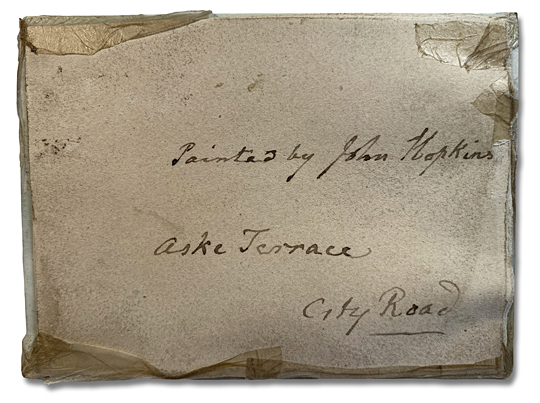| |
English Artist: John Hopkins


Young, Georgian Lady, Painted in the Nude and
Depicted in a Symbolic, Romanesque Scene
English
circa 1811-1813
by John Hopkins (fl. 1791-1813)
(Inscribed to reverse, "Painted by John Hopkins / Aske Terrace / City Road")
3 3/4 x 2 3/4 inches (sight)
watercolor on ivory; housed in a hinged, red leather traveling case (only partially shown)
This provocative portrait miniature dates to the period of 1811 to 1813, when John Hopkins lived at Aske Terrace. (Notes on the portrait's backing paper clearly state that it was painted by John Hopkins of Aske Terrace; and London public records document Hopkins as having lived at that address between 1811 and 1813.)
The identity of the young lady is unknown, but it is presumed that she was the lover or mistress of a military officer (surmised by the present of ancient military paraphernalia). Was he perhaps fighting against France in the Napoleonic Wars, or fighting against America in the War of 1812? Wherever he may have been, he likely carried this portrait with him, perhaps even on his person, as it is housed in a compact traveling case that could be discreetly tucked away from the view of others.
Making the portrait particularly special, Hopkins has included rich, Romanesque symbolism. Beside the young lady are a Roman soldier's helmet, shield and sheathed sword; and she rests atop her lover's cloak. Also depicted are two doves, symbolizing ever-faithful love.

Note inscribed by the artist on card and affixed to the reverse of the portrait miniature
About the Artist: Little is known about John Hopkins' origins or personal life. This is compounded by the fact that he had a very common name and that it has been difficult to discern which public records apply to the artist as opposed to the numerous other John Hopkins who lived during his lifetime. It is supposed that he was born in Ireland, but this has not been confirmed; nor has research been able to pinpoint his years of birth or death. He is known to have lived in both London and Dublin. Between 1791 and 1798, he exhibited 15 portraits at the Royal Academy of Arts from the London address of 27 King Street, Holborn. In 1800, he exhibited 18 works (both portraits and landscapes) in Dublin, at the Society of Artists in Ireland. His address at the time was listed as No. 27 Dame Street, Dublin. Between 1802 and 1804, he exhibited 5 portraits at the Royal Academy from the London address of 7 Cornhill. After a hiatus of 5 years, he then exhibited again at the Royal Academy in 1809, from the address of 42 Pall Mall. He is recorded in London city directories at 13 Aske Terrace from 1811 to 1813. (The miniature portrait by him in the Tormey-Holder Collection was painted during this period -- evidenced by notes on the portrait's backing paper that read "Painted by John Hopkins / Aske Terrace / City Road".) In the years 1822 and 1825, he was listed in London city directories as living at 60 Shoreditch. Thereafter, no records can be found of John Hopkins as an artist. It is possible that he may have died shortly thereafter or that he may have retired to Ireland (where records of the period are sparse). Daphne Foskett, citing Basil S. Long, reports that Hopkins had a widow who died in May 1835 in "distressed circumstances". Both an Isabel Hopkins and a Theresa Hopkins are recorded as having died in London in May 1835 (aged 59 and 80 years old, respectively). No records have been found, however, documenting a John Hopkins having married either an Isabel or a Theresa, so this claim remains dubious. Hopkins is known to have works in collections of the British Museum (London) and the Victoria & Albert Museum (London). He painted both miniature portraits in watercolor on ivory and full sized portraits and landscapes in oil on canvas. He frequently incorporated neoclassical symbolism into his paintings. Listed by Benezit, Blättel (pages 476, 477),
Foskett (page 569) and Schidlof (page 373).
|
|